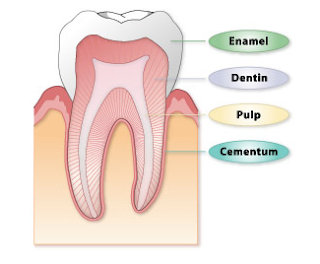Teeth
Teeth are the hardest structures of
the human body. The type, number, and arrangement of a set of teeth represent
the dentition. Humans have two
sets of teeth:
Primary
teeth are also known as deciduous teeth, milk teeth,
baby teeth or temporary teeth. Primary teeth start to form during
the embryo phase and erupt during infancy (from 6 months to 3 years).
Permanent
teeth (or adult teeth) are the second set of
teeth and normally consist of 32 teeth. The first permanent teeth appear around
the age of 6 and are usually the first molars which erupt right behind the last "milk" molars of the primary
dentition.
Most
of us take our teeth for granted — until something goes wrong. Not only do
our teeth
help us chew and digest food, they also play an important role in speech, and
impact our health overall. By brushing up on your dental health knowledge,
you’ll be taking the first step toward giving your teeth the attention they
deserve.
Parts of the Tooth
A tooth is divided into two basic parts: the crown, which is the
visible, white part of the tooth, and the root, which you can’t see. The root
extends below the gum line and helps anchor the tooth into the bone. Your teeth
contain four kinds of tissue, and each does a different job. These include:
· Enamel: This is the visible
substance that covers the tooth crown. Harder than bone, enamel protects the
vital tissues within the tooth. Enamel is made up of hydroxyapatite,
phosphorous, and calcium.
· Dentin: Underneath the enamel, you find dentin, which is calcified and
looks similar to bone. Dentin is not quite as hard as enamel, so it's at
greater risk for decay should the enamel wear away.
· Cementum: This tissue covers the
tooth root and helps anchor it into the bone. It's softer than enamel and
dentin; the best way to protect this softer tissue from decay is by taking good
care of your gums. Cementum has a light yellow colour
and is usually covered by the gums and bone. But with inadequate dental care,
the gums may become diseased and shrink, exposing the cementum to harmful
plaque and bacteria.
· Pulp: Pulp is found at the center and core of your tooth and contains the blood vessels,
nerves, and other soft tissues that deliver nutrients and signals to your
teeth.
Types of Teeth
Each type of
tooth has a slightly different shape and performs a different job. Types of
teeth include:
· Incisors: Incisors
are the eight teeth in the front of your mouth (four on top and four on
bottom). These are the teeth that you use to take bites of your food. Incisors
are usually the first teeth to erupt — at around 6 months for your baby teeth,
and between ages 6 and 8 for your adult set.
· Canines: Your
four canines (fangs) are the next type of teeth to develop. These are your
sharpest teeth and are used for ripping and tearing food apart. Primary canines
generally appear between 16 and 20 months, with the upper canines coming in
just ahead of the lower canines. In permanent teeth, the order is reversed,
with lower canines erupting around age 9 and the uppers arriving between ages
11 and 12.
· Premolars: Premolars,
or bicuspids, are used for chewing and grinding food. Adults have four
premolars on each side of their mouths — two on the upper and two on the lower
jaw. There are no primary premolars; the first premolars appear around age 10,
with the second premolars arriving about a year later. These take the places of
the first and second primary molars.
· Molars: Molars
are also used for chewing and grinding food. Primary molars, also known as
deciduous molars, appear between 12 and 28 months
and are replaced by the first and second premolars (four upper and four lower) described above.
The permanent
molars (also four upper and four lower) do not replace any primary teeth, but
come in behind all of them, further back in the jaw. The first permanent molars
erupt at around age 6 (before the primary molars fall out), while the second
molars come in between ages 11 and 13.
· Third
molars: The third molars are commonly known as
wisdom teeth. These are the last teeth to develop and don't typically erupt
until age 18 to 20. Some people never develop third molars at all. For those
who do, these molars may cause crowding and need to be removed. If they don't
fully erupt they are said to be impacted,
and are commonly removed.
Your mouth is important, so don’t take your teeth
or oral health for granted. For good dental health, brush and floss your teeth
regularly, don't smoke, eat a healthy diet, and see your dentist regularly for
dental cleanings and check-ups. A healthy mouth makes for a healthy body —
and a pretty smile.



Comments
Post a Comment